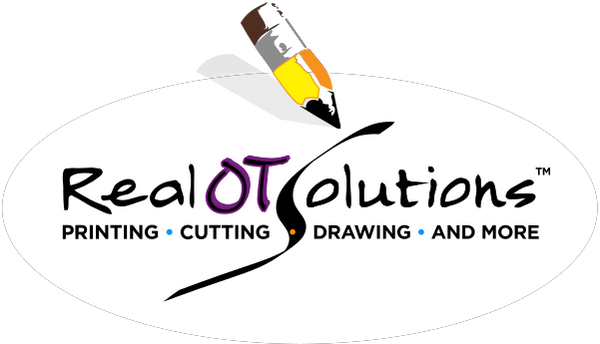Key Takeaways
- The Size Matters® Handwriting Program is a well-researched, evidence-based practice that has been proven to improve legibility by teaching consistency of letter size. When children focus on letter size, accuracy of letter formation follows.
- In addition to improving handwriting, SMHP® also helps teach children other life skills they need to succeed, including self-actualization and self-determination. Kids determine their practice by rolling the dice. And by teaching them the Rules for Letter Size, they can monitor their own progress.
- Through Size Matters®, Real OT Solutions® encourages teachers to be particular in their handwriting instruction, so students have clearly defined rules to help them improve.
Letter Sizing Matters
The rules for the Size Matters® Handwriting Program are “packaged” as a song-and-dance learning experience because it’s so particular and specific. Teaching kids the Rules for Letter Size is essentially like giving them the answers to the test and the key factor in ensuring the effectiveness of our program. Learn more about the approach SMHP® takes toward letter sizing and how to shape letters to discover the way it pays tribute to multiple theories of motivation.
Motivating Children to Learn
When they’re younger, children are passionate about learning. They want to get to know the people and the world around them. Size Matters® leverages this type of motivation to ensure students get the most out of the program by focusing on handwriting size. Here are a few types of motivation that Real OT Solutions® uses to ensure the best possible handwriting program.
1. Self-Actualization
Self-actualization is the drive to master something new. Kids want to learn how to print and perfect the overall shape or form of letters. And when they are young, they want very much to get it right. When you present learning about letter sizing as an important part of the process, students are easily able to master the key variable impacting legibility, and thus feel successful... or self-actualized... in their pursuit of becoming functional legible printers.
2. Goal or Achievement Theory
This type of motivation is all about reaching an end goal. There are three components to this theory, including Proximity, Difficulty, and Specificity:
- Proximity: How long will it take students to get to the end? In the Size Matters® writing program, the time it takes students to learn how to write is up to them. And it's as simple as rolling dice. Whatever they roll is the number of times they have to make a STAR-WORTHY LETTER. The more they focus on handwriting size and the overall shape or form of letters, the faster they achieve legibility.
- Difficulty: How achievable is the challenge? With SMHP®, students are given work that’s appropriate to their skill level. They may be working on anywhere from letter sizing for 1, 2, 3, 5, or 20 letters at a time. However, our program encourages teachers and therapists to assign only as many letters as children can handle, with a score of 80%. Once students achieve this with their current crop of letters, you can advance to higher difficulty levels.
- Specificity: When goals are clearly defined, students feel safe knowing what rules they have to follow. Concrete metrics provide them with real goals and rewards for success in letter sizing.
3. Self-Determination
Children want to feel competent and validated. Real OT Solutions® uses this type of motivation by putting the knowledge and control into the hands of students. We repeat over and over that we believe in them, giving them the handwriting resources they need to succeed through various instructions, tools, and accessories.
4. Motor Learning Theory
Constant, blocked practice times ensure students focus on remembering letter sizing and shape rules. This is the drill and practice part of learning a new motor skill. However, for the skill to be integrated into their daily repertoire, it must be revisited throughout the day in random variable practice. Integrating handwriting practice during other lectures and learning times provides students with even more opportunities to practice handwriting size without even knowing it!
How to Create Success With SMHP®
Simply following the program guidelines is enough to help students improve their handwriting. However, if you want to see more success from your students, consider these tips:
- Include children in the process
- Teach them the rules
- Let them determine their practice
- Give them tools to score their progress
- Only hold them responsible for letters learned
… And make it fun!
How to Teach Size Matters®
One of the reasons Size Matters® is so successful is that you’re providing students with the information they need to critique and score their own printing on the overall size of letters. These are definitive, measurable, and observable goals that specifically detail what neat printing and letter sizing should look like. Here are some tips that ensure your style of teaching handwriting is clear and understandable:
- Be literal with your guidance.
- Define the guidelines on the writing paper: Top Line, Bottom Line, Middle Line.
- Define where printing should start and end: Go Line and Finish Line.
- Use the same terminology across all instruction.
- Ensure students touch the lines on the adaptive paper (close enough doesn’t work).
- Focus on letter sizing, and form will follow.
All of the instruction booklets and handwriting workbooks are designed to complement each other, using the same terminology, imagery, and guidance. Choose Size Matters® for teaching children handwriting to discover the difference this type of program can make to their progress.
Here to Help!
In addition to curriculum, lesson plans, and practice accessories, Real OT Solutions® also provides educators with webinars and online courses that improve their teaching methods. Whether you’re a parent who’s homeschooling your children or a therapist/teacher interested in teacher professional development, our team can help! Join our OT courses online to enhance your skills as an educator.


